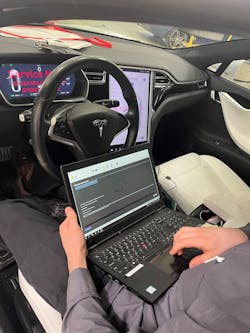What new-technology training is needed by your collision repair technicians?
Content brought to you by ABRN. To subscribe click here.
What you will learn:
• Training doesn't cost, it pays
• Evolving technologies makes consistent training ever more important
• Training not only improves the technician's skillset but also provides a safer work environment
The skeptical shop owner says, “What if I invest in training my staff, and they leave, costing me money but only benefitting their next employer?”
The weary consumer replies, “What if you don’t train them, and they stay?”
This hypothetical conversation illustrates a shop philosophy based on fear and ignorance, though it is unfortunately too common in our industry, and one whose negative impact is increasing due to changing vehicle technologies.
We are in a time where an increased level of staff training is not only a good idea but has become a necessity. And the need is imminent. New sophisticated vehicle technology is in the vehicles of today. The future is here now.
Dirk Fuchs, I-CAR director of technical programs and services, said, “The technical tsunami is approaching our industry so fast that we from I-CAR have to keep up with beneficial course development for the industry. Students have to learn totally new knowledge and skills to stay on top of modern vehicle technology to be capable of providing a quality and safe repair. Sensor technologies, high-voltage systems, "megohms and milliohms,” “zero potential,” and a lot more is our new vocabulary, and I-CAR is ready to pass this knowledge onto the industry.”
Let’s look at what a collision repair MSO can and should be doing.
ADAS
First and foremost, as repairers, we need to prioritize safety: the safety of the vehicle, the safety of the consumer, and the safety of our staff. Advanced driver assistance systems (ADAS) are designed around some areas of convenience but primarily around safety. Consumers are more safety-conscious than ever. We have a moral obligation to protect our customers and staff, and the costs of litigation are greater than ever. We have become accustomed to frequent discussions evolving around severity and cycle time, especially when interacting with insurers. The topics are ingrained in the culture of our industry. What I am saying is that the topic of safety should rise beyond that. When analyzing damage and repairs, our first questions should be regarding safety. While severity and cycle time are important, they are secondary to safety.In too many cases, people in our industry will say they provide safe repairs, but they take a casual approach to their definition of the term. “Good enough,” “Shouldn’t be a problem,” and “It will be fine” are rationalizing phrases that illustrate my point in repair methodologies that compromise. Most of us have dealt with that insurance claims person who behaves as if protecting low premiums is among his or her highest priorities in life, or that tech who just wants the job completed and out of his or her stall, or the estimator who is fearful of the customer’s reaction to additional costs. These are situations where it becomes easy to cut corners, perhaps neglecting a scan or calibration, or using a compromised part.
Training and education are the keys to the safe repair. Knowledge is king. And in today’s world, that may mean not necessarily having all the answers, but instead knowing how and where to find them.
Embrace ADAS. It’s a whole new aspect to the repair industry. It is sophisticated and complicated. But it is relatively clean work that can create a new profit center.
And consider all the staff in your shop. Each person must have at least some basic understandings of new technologies. Our estimating staff today has to be able to educate insurers and consumers as they describe repair processes and negotiate charges.
There are now many classes from vehicle manufacturers, independent training sources, parts suppliers, and more. And of course, our industry’s dominant source of training is I-CAR. It offers many classes to help staff get started, such as, “ADAS and Convenience Systems Overview and Service,” “Incorporating ADAS into Your Business,” and “Understanding OEM Calibration Procedures and How to Locate Them”.
Start by cultivating a culture of learning. Statistically, companies that do so perform better and are more successful. While there are always those who grumble about the inconvenience, cost, and quality of training, it is up to management to set the tone that instead, training is a privilege to elevate one’s performance and career. Most shops pay for registration costs, and many cover the costs of lost wages while training. In today’s world, we must accept that hiring and maintaining staff is simply a more expensive proposition than it used to be, especially in light of staff shortages.
Embracing training
In the company I work for, we embraced ADAS starting about seven years ago. We started with performing one scan for nearly every vehicle and quickly evolved into performing two scans (pre and post) for every repaired vehicle, as has been directed by virtually every vehicle manufacturer. Using our own staff and outside sources, we elected to train to grow that portion of our business. We developed some of our own presentations and trained our staff extensively on ADAS, including body techs, estimators, and CSRs. Everyone involved in and around collision repair should have at least some knowledge of ADAS.
While electric vehicles (EV) seem to be the hot topic in the trade press, and their prevalence is gaining and will continue to do so, remember that now and for some time in the future, EV vehicles represent a small portion of all vehicles sold. Yet today, virtually every new vehicle is equipped with at least some, if not a lot, of ADAS equipment.
If you repair mainstream late model vehicles and don’t embrace ADAS, you are on the path of the dinosaur.
At my company, our ADAS work has evolved into having dedicated calibration areas and the ability to perform extensive calibrations, programing, diagnostics, and more. And our frequency of training is increasing. Reading has become a prevalent necessity. Whether it is reading training materials or reading vehicle manufacturer repair procedures, it is a key requirement. We embrace the concept of piloting new ADAS equipment when given the opportunity. The product may or may not work out, but we always learn from it. And when it is successful, we find ourselves ahead of the competition. We also embrace vehicle manufacturer certifications. Among the benefits is valuable cutting-edge training.
Electric vehicles
Most vehicle manufacturers are embracing EVs and are investing heavily. No question, we are going to see more EVs, especially as manufacturers continue to refine them. But it is only a small portion of the current market and will take some time to become a big portion of our national fleet.
At my company, we have Tesla certifications in most of our shops. And as a result, we’ve become quite comfortable working on them. At any given time, we have many in process. Yet we’ve had a lot of training and have purchased a lot of equipment. And now it’s not hard for us to adjust to working on other brands of EV’s, even though they are much different in many ways from internal combustion engine (ICE) vehicles.
But with EVs, training is even more important, primarily because of safety concerns. Our human bodies conduct electricity, and the high-voltage batteries in EVs can literally kill; there is no margin for error.
Presentations from I-CAR reveal that there are many extra steps in approaching an EV repair, starting with a visual inspection, where you should park the vehicle (especially if any components are hot or suspect), to how you disconnect the ignition, high-voltage battery, and 12V battery. They also train that one should perform extra checks with voltmeters and ohmmeters in the initial disconnect process as well in the reconnect process. They educate on how contamination on connectors, such as paint overspray, can increase electrical resistance, thus building heat and potentially creating a fire.
I-CAR has many classes available, with more coming. It has introductory classes such as “Understanding High Voltage Safety” and “Introduction to Electric Vehicles.”
In a shop that works on EVs, these should be mandatory for virtually everyone, in my opinion. Some classes are more technical and some are brand-specific. And for those who really wish or need thorough training, there is “Electric Vehicle (EV) Disconnect, Initialization, and Safety 5-Day Hands-On Skills Development”.I had a chance to catch up with Bud Center, director of technical products and curriculum of I-CAR. When I asked him about training on vehicle new technologies.
“When we think about where we are with ADAS and EV (high voltage) on modern vehicles and where we’ll be in the coming years, it is very clear there is a large knowledge gap that needs to be addressed. We won’t be able to continue repairing vehicles the same way we’ve done in the past and still produce a complete, safe, and quality repair," he said.
"Repairers will need to obtain a new knowledge and skill set for repairing these vehicles, skills necessary to ensure vehicles will perform as designed when they are returned to the vehicle owner and skills necessary to ensure the safety of everyone in the shop working with these vehicles."
The message is clear. As an MSO in the collision repair industry, you have no choice. Vehicle sophistication and complexity require us to get more training. Embrace it. Budget for it, including in how you calculate your billing. Incorporate it into your culture and business model. And welcome the future instead of fearing it. Knowledge is power.
About the Author
Darrell Amberson
Vice president of industry and OEM relations
Darrell Amberson is the vice president of industry and OEM relations at Quality Collision Group.
Previously, he was president of operations for LaMettry's Collision, a 10-location multi-shop operator in the Minneapolis area purchased by Quality Collision Group in November 2024. Amberson has more than 40 years of collision industry experience and served as chairman of the Collision Industry Conference for the 2021-2022 term, as well as interim chairman for the first two CIC meetings of 2024.

